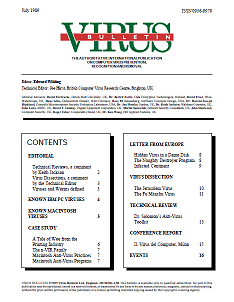Neither subscription nor registration required to access content.
Happy birthday
Virus Bulletin
! Today it is exactly 25 years since, in the very first issue of
Virus Bulletin
, Editor Edward Wilding wrote: “We aim to provide PC users with a regular source of intelligence about computer viruses, their prevention, detection and removal, and how to recover programs and data following an attack.”

It is an understatement to say that things have changed in the 25 years since then. Both computers and threats are far more prevalent and more complex than they were in 1989 – at which time there were probably more virus researchers than computer viruses.
Virus Bulletin
‘s focus has changed too: from viruses, via malware and later also spam, to threats in general – and apart from the magazine, we now have the
conference
and the
VB100
and
VBSpam
tests, all of which contribute to the goal of informing computer users in general, and the security community in particular, about threats, their detection and prevention.
However, today marks an important change that we believe will help us in achieving this goal. As of today, all content published in
Virus Bulletin
will become freely available – not only do you no longer need a subscription, you don’t even need to be a registered user on our website to access the content.
In another change that will help us to highlight the high-quality research that is published through
Virus Bulletin
, from now on, articles will be published individually and frequently throughout the month, with at least one appearing every week.
The first of such articles will be published tomorrow.
For now, you might want to have a browse through our vast archives – perhaps to download a PDF version of the
very first issue
of Virus Bulletin. Or to read something more recent:
In a comment piece published in February, Andreas Lindh (
I Secure
)
argued
that it was time for those working in defensive security to go on the offence. Two months later,
RSA
‘s Chad Loeven
made the case
for the implementation of standardized threat data sharing.
A significant part of
Virus Bulletin
still consists of threat analyses. Earlier this year,
Fortinet
‘s Raul Alvarez wrote a two-part analysis (
1
,
2
) of Sality, while Sophos’s Gabor Szappanos dug deep into the
Simbot trojan
. In May,
F-Secure
‘s Wayne Low
explained
how the Turla malware family exploited two elevation-of-privilege vulnerabilities, while earlier in the year, in another two-part analysis (
1
,
2
),
Symantec
‘s Liang Yuan analysed the Xpaj.B file infector.
Other aspects of the threat landscape have also long been part of
Virus Bulletin
‘s remit. In May, Alisa Esage used a
real-world example
to shed light on the typical cyber investigation process, while Paul Baccas (
Proofpoint
)
reviewed
the new novel by
Sysinternals
author Mark Russinovich. In his
Greetz from academe
series, John Aycock from the University of Calgary has highlighted some of the work going on in academic circles.
Perhaps you are tasked with defending your organisation’s network, or would just like to know how well products perform against today’s threats. You will be pleased to learn that our test reports have become free as well. In the February
VB100 review
, we looked at performance of anti-malware solutions for
Ubuntu Server
, while in the
latest VBSpam report
, we saw 15 email security solutions achieve a VBSpam award.
As you may have noticed, we have also made some small changes to the website – and we will be making further changes in the coming months. One change we made recently was to switch the website to using HTTPS by default. We want to provide you with content, regardless of who you are. We don’t think anyone who simply happens to have a “privileged network position” should know that you are visiting our website either. (We should thank Christopher Soghoian of the ACLU, who gave the
keynote address
at VB2012, for repeatedly urging websites to make HTTPS the default.)
All articles we publish will be accompanied by a
blog post
, so if you haven’t done so already, there is now even more reason to add the
RSS feed
to your RSS reader. We will, of course, also announce the articles on
VB
‘s
Facebook
and
Twitter
pages.
Did we mention we are excited about these changes? We hope you are too, and that you will find accessing the content we publish even easier. (Perhaps you will even be inspired to
contribute
yourself.) Of course, should you find anything that isn’t working, please don’t hesitate to
let us know
.
Here’s to the next 25 years!
Posted on 01 July 2014 by
Martijn Grooten
Leave a Reply